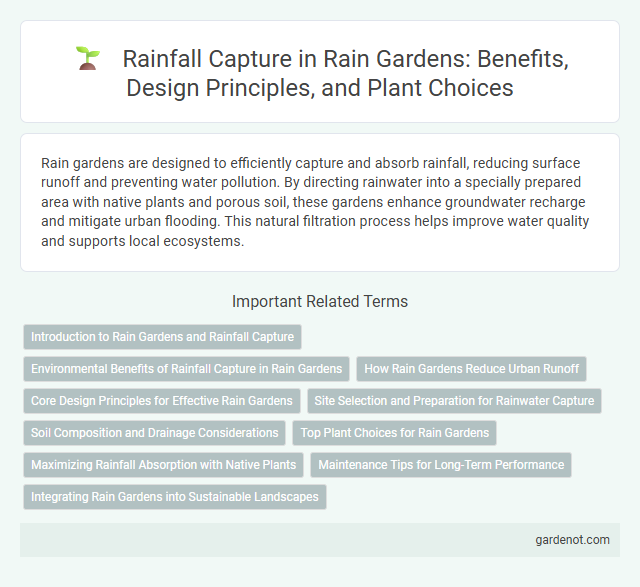Rain gardens are designed to efficiently capture and absorb rainfall, reducing surface runoff and preventing water pollution. By directing rainwater into a specially prepared area with native plants and porous soil, these gardens enhance groundwater recharge and mitigate urban flooding. This natural filtration process helps improve water quality and supports local ecosystems.
Introduction to Rain Gardens and Rainfall Capture
Rain gardens effectively capture rainfall by collecting and absorbing stormwater runoff from impervious surfaces such as roofs, driveways, and sidewalks. These shallow, planted depressions use permeable soil and native vegetation to filter pollutants and reduce the volume of runoff entering storm drains and waterways. By managing rainfall onsite, rain gardens mitigate flooding, replenish groundwater, and improve water quality in urban environments.
Environmental Benefits of Rainfall Capture in Rain Gardens
Rain gardens enhance environmental sustainability by efficiently capturing and filtering stormwater runoff, reducing surface water pollution and minimizing urban flooding risks. These gardens promote groundwater recharge by allowing rainfall to infiltrate the soil, replenishing local aquifers and supporting native vegetation. Moreover, rain gardens help mitigate the heat island effect and improve biodiversity by providing habitats for pollinators and other wildlife.
How Rain Gardens Reduce Urban Runoff
Rain gardens effectively reduce urban runoff by capturing and infiltrating rainfall, preventing excess water from overwhelming storm drains and waterways. These landscaped depressions use permeable soil and native plants to absorb and filter rainwater, minimizing pollutants and erosion. By managing stormwater on-site, rain gardens mitigate flooding risks and improve urban water quality.
Core Design Principles for Effective Rain Gardens
Rainfall capture in rain gardens relies on core design principles such as optimal sizing based on watershed area and rainfall intensity, ensuring sufficient soil permeability to promote infiltration, and incorporating native vegetation with deep root systems to enhance water absorption and pollutant filtration. Effective rain gardens typically manage runoff from roof areas of 500 to 1,000 square feet, using a soil mix of 60% sand, 20% compost, and 20% topsoil to balance drainage and nutrient retention. Strategic placement in low-lying or naturally depressed areas maximizes water retention time, reducing stormwater volume and improving groundwater recharge rates.
Site Selection and Preparation for Rainwater Capture
Selecting a site with proper soil permeability and proximity to downspouts enhances rainwater capture efficiency in rain gardens. Preparing the area involves removing impermeable surfaces and shaping the soil to direct runoff into the garden basin. Ensuring a gentle slope and incorporating native plants improves infiltration and supports sustainable stormwater management.
Soil Composition and Drainage Considerations
Optimal soil composition for rain gardens includes a balanced mix of sand, silt, and organic matter to enhance infiltration and support plant growth. Proper drainage considerations involve assessing underlying soil permeability to ensure efficient water absorption and prevent pooling. Incorporating layers such as gravel beneath the soil can improve subsurface drainage and reduce the risk of waterlogging.
Top Plant Choices for Rain Gardens
Native grasses such as Blue Fescue and Switchgrass excel in rainfall capture by facilitating water infiltration and reducing runoff. Perennials like Black-eyed Susan and Purple Coneflower offer deep root systems that enhance soil absorption and filter pollutants effectively. Shrubs such as Red Twig Dogwood contribute to rain garden performance by stabilizing soil and promoting moisture retention during heavy rainfall events.
Maximizing Rainfall Absorption with Native Plants
Maximizing rainfall absorption in rain gardens relies heavily on selecting native plants with deep, fibrous root systems that enhance soil permeability and water retention. These plants naturally adapt to local climate and soil conditions, promoting efficient infiltration and reducing runoff. Incorporating species like switchgrass, coneflowers, and blue flag iris supports sustainable water management by optimizing rainfall capture and absorption in the ecosystem.
Maintenance Tips for Long-Term Performance
Rainfall capture in rain gardens requires regular maintenance to ensure long-term performance, including periodic inspection for sediment buildup and removal of debris to prevent clogging. Maintaining healthy vegetation through pruning and replanting supports water absorption and filtration effectiveness. Mulching annually helps retain soil moisture and reduces erosion, optimizing the rain garden's capacity to capture and manage stormwater runoff efficiently.
Integrating Rain Gardens into Sustainable Landscapes
Rain gardens effectively capture and infiltrate rainfall, reducing stormwater runoff by up to 30%, which helps prevent urban flooding and recharge groundwater. Incorporating native plants with deep root systems enhances soil absorption and pollutant filtration, promoting healthier ecosystems within sustainable landscapes. These gardens also support biodiversity by providing habitats for pollinators and contribute to improved air and water quality in urban environments.
Rainfall capture Infographic

 gardenot.com
gardenot.com